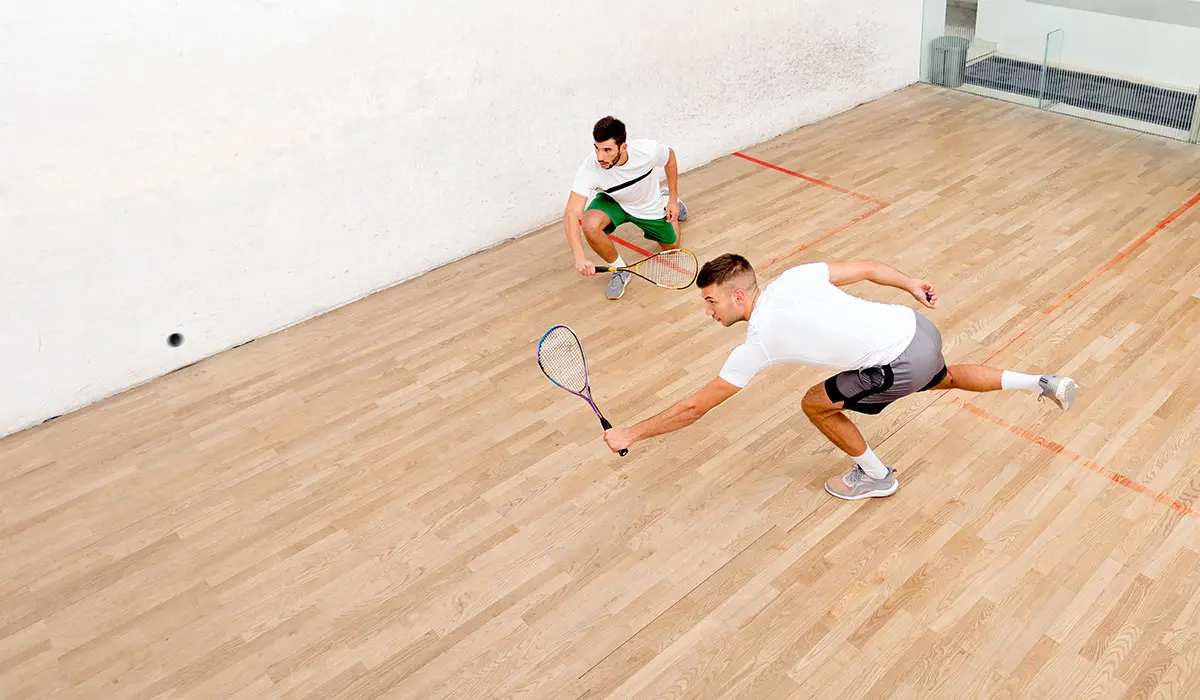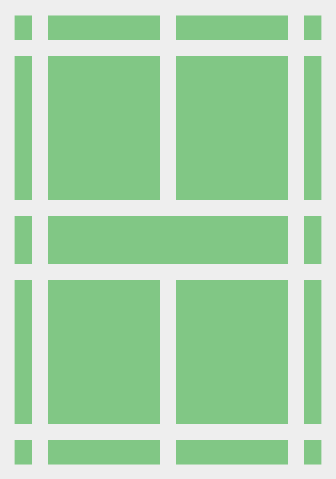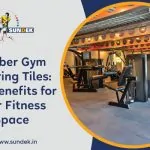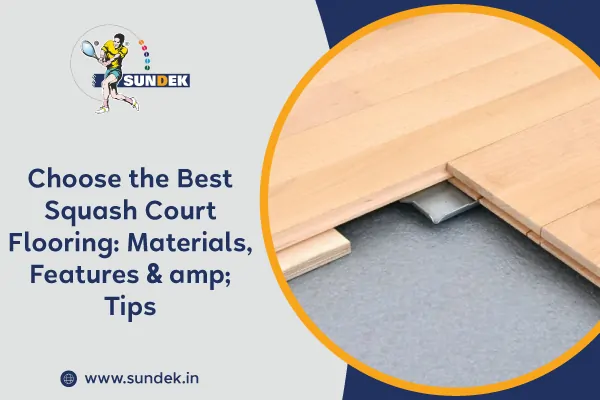Choosing the best squash court flooring is essential for ensuring optimal performance and safety. The right flooring will not only affect how players perform but also contribute to their safety by offering proper grip and shock absorption. Flooring materials like hardwood, vinyl, and rubber each have their benefits, such as durability, ease of maintenance, and comfort for players. For professional-level courts, hardwood flooring is often the preferred choice due to its superior performance and aesthetic appeal. For recreational courts, vinyl or rubber flooring provides cost-effective solutions with good performance characteristics. Selecting the right flooring based on your needs and budget is key to building a high-quality, long-lasting squash court. It ensures that players can enjoy the game while reducing the risk of injuries. Invest in the best flooring for your squash court to enhance player experience and prolong the life of your facility.
Why Selecting the Right Flooring Matters
The quality of the flooring in a squash court can greatly influence the speed, quality, and safety of the game. It must meet certain criteria to ensure the players can perform at their best without risk of injury. Additionally, proper flooring helps maintain the aesthetic and structural integrity of the court over time, providing a surface that meets both professional and recreational standards. Therefore, understanding the options available and how each type of flooring will meet your needs is critical in selecting the best choice.
Factors to Consider When Choosing Squash Court Flooring

Selecting the right flooring for your squash court involves several key considerations. These include the durability of the flooring, the amount of maintenance required, cost, and specific features that affect performance, such as surface grip and shock absorption.
Durability
Squash courts are subject to a lot of use, with players constantly running, sliding, and hitting the ball against the walls. These makes the flooring particularly exposed to wear and tear. A durable flooring solution is essential to ensure the court can withstand heavy foot traffic, the impact from the ball, and the abrasions caused by players’ shoes. The more durable the flooring, the longer it will last, making it a wise investment for any facility. Hardwood, vinyl, and rubber floors each have their strengths and weaknesses in terms of durability, so it’s important to assess the specific needs of your court.
Surface Grip
Grip is one of the most important factors to consider when choosing squash court flooring. Squash is a fast-paced game that involves quick direction changes, sprints, and dynamic foot movements. A floor with insufficient grip might increase the danger of slipping and sustaining injury. It’s essential to select flooring that provides a stable surface for players, ensuring they can move freely without fear of falling. Flooring like rubber and vinyl is often preferred for their excellent grip, reducing the risk of accidents during the game.
Shock Absorption
Another critical aspect of squash court flooring is its shock-absorbing properties. Squash players often make sudden, high-impact movements, and repetitive stress on joints can cause long-term injuries. Flooring that offers good shock absorption helps reduce the strain on players’ knees, hips, and ankles, contributing to a more comfortable experience. Rubber flooring, in particular, offers excellent shock absorption, making it an ideal choice for players who spend a lot of time on the court.
Maintenance
Maintenance is another important factor when considering squash court flooring. Floors that require frequent cleaning or special treatments can become a burden, especially for facilities that see heavy use. Hardwood floors, while beautiful, may require more upkeep compared to other materials, such as vinyl and rubber, which are known for their ease of maintenance. Easy-to-clean floors help maintain hygiene and ensure the longevity of the flooring without incurring additional maintenance costs.
Cost
Cost is always a key consideration when making a purchase decision. While high-end hardwood flooring may offer an exceptional playing experience, it may not fit into every budget due to the installation and maintenance costs. On the other hand, options like vinyl and rubber flooring are generally more affordable, providing an excellent balance of quality and cost-effectiveness. It’s important to evaluate your budget alongside other factors such as durability, ease of maintenance, and performance to find the best flooring that meets both your financial and functional needs.
Different Types of Squash Court Flooring
When it comes to choosing the best flooring for your squash court, there are a few different types to consider. Let’s break down the most common options and their advantages and disadvantages.
Hardwood Flooring
Hardwood flooring is the traditional choice for many squash courts, especially in professional or competitive settings. It provides a firm, durable surface that plays well, allowing for fast ball bounce and excellent traction. Maple and oak are popular hardwood alternatives for their strength and longevity. However, hardwood floors can be expensive to install and maintain, requiring regular refinishing to ensure long-term performance. Despite the maintenance challenges, hardwood floors remain a top choice due to their premium look and feel.
Vinyl Flooring
Vinyl flooring is a popular option for those looking for a cost-effective and easy-to-maintain solution. It offers good grip and durability while requiring minimal upkeep. Vinyl flooring is available in various designs and can be customized to match the aesthetic of your facility. It is less expensive than hardwood and can withstand heavy foot traffic, making it ideal for both recreational and professional squash courts. Additionally, vinyl floors provide excellent shock absorption and are relatively easy to clean, making them a convenient choice for busy environments.
Rubber Flooring
Rubber flooring is an excellent option for shock absorption and comfort. It is specifically advantageous to players who spend a lot of time on the court. Rubber flooring is highly durable and resistant to wear and tear, making it a great choice for high-traffic courts. It also offers sound insulation, which reduces noise levels, creating a more comfortable environment for both players and spectators. The downside of rubber flooring is that it may not provide the same speed of play as hardwood, but for many facilities, the benefits outweigh this concern.
Concrete Flooring
Because of its weather-resistant properties, concrete flooring is commonly utilized for outdoor squash courts. While it is durable and inexpensive, concrete flooring does not offer the same comfort or performance as other options. It can be rough on players’ joints due to the lack of shock absorption, making it less ideal for long sessions of play. If you’re on a budget or building an outdoor court, however, concrete flooring can be a good choice for basic functionality.
Choosing the Best Squash Court Flooring for Your Needs
When selecting the right flooring for your squash court, it’s essential to consider several factors. Whether you are outfitting a professional facility, a local community center, or a home gym, understanding the specific requirements of your space will guide your decision-making.
First, consider the level of play. Professional squash courts will require a high-quality, performance-focused surface, like hardwood or premium vinyl, while recreational courts may benefit from more cost-effective options like rubber or basic vinyl. Additionally, the size of the court and the amount of foot traffic will play a role in determining which material best suits your needs.
Budget is another key factor. While hardwood floors are often considered the gold standard, they can be costly to install and maintain. Rubber and vinyl flooring options can provide a comparable experience at a fraction of the cost. For outdoor courts, concrete flooring may be the most affordable, but it should be complemented with an appropriate finish to ensure it’s playable.
Consulting with experts or manufacturers can provide valuable insights into which flooring material is the best fit for your specific application. A professional can help you navigate your options and select the right flooring based on your needs, budget, and expected use.
Who is the Leading Manufacturer of Squash Court Flooring?
Sundek Sports Private Limited is India’s top manufacturer of the best squash court flooring, offering top-notch flooring solutions for both professional and recreational courts. Their products are designed to provide exceptional durability, performance, and safety. Sundek Sports ensures that every installation meets the highest standards, delivering reliable and long-lasting flooring for your squash court. Whether you’re renovating an existing court or constructing a new one, their expert team offers comprehensive support, including guidance on material selection, proper installation, and ongoing maintenance services. Sundek Sports offers various options, from hardwood to vinyl and rubber flooring, all tailored to meet your specific needs. As a trusted Squash Court Flooring manufacturer, Sundek Sports Private Limited is committed to delivering superior products that enhance the performance and aesthetics of any squash facility. With years of experience and expertise, Sundek Sports stands out as the ideal choice for anyone looking to invest in quality squash court flooring solutions in India. Call now for your free consultation and expert advice on flooring options.
Conclusion
Choosing the best flooring for your squash court is an important decision that impacts the performance, safety, and longevity of your facility. From hardwood to vinyl and rubber flooring, each option offers its own set of advantages and trade-offs. It’s essential to consider factors like durability, maintenance, cost, and player comfort when making your choice. Investing in high-quality flooring will not only improve the playing experience but also save you time and money in the long run.
For more information on selecting the right squash court flooring and to get the best products and services, contact Sundek Sports Private Limited at +91 93203 08938 or email info@sundek.in. Let them help you build the ideal court for your needs.
FAQ
What are the best flooring options for squash courts?
The best flooring options for squash courts include hardwood, vinyl, and rubber, each offering different benefits such as durability, grip, and ease of maintenance.
Why is flooring important in a squash court?
Flooring provides essential grip, shock absorption, and durability, helping prevent injuries and ensuring a safe, comfortable playing surface for players during games.
What kind of flooring is utilized on reliable squash courts?
Professional squash courts commonly use high-quality hardwood floors, like maple or oak, due to their performance characteristics and smooth, durable surface.
Is vinyl flooring suitable for squash courts?
Yes, vinyl flooring is a popular choice for squash courts due to its affordability, durability, easy maintenance, and ability to provide a good level of grip for players.
How does rubber flooring benefit a squash court?
Rubber flooring offers superior shock absorption, reducing the risk of joint strain, while also providing good grip and sound insulation for a quieter, more comfortable play environment.
What’s the difference between hardwood and vinyl flooring for squash?
Hardwood offers superior performance, better ball bounce, and a traditional aesthetic, while vinyl is more affordable, low-maintenance, and suitable for recreational courts with adequate performance.
Is maintenance easy for squash court flooring?
Vinyl and rubber flooring are generally easier to maintain, requiring only regular cleaning, while hardwood requires periodic refinishing and careful maintenance to retain its performance.
How long does squash court flooring last?
The lifespan of flooring depends on the material and usage. Hardwood can last 20+ years with proper care, while vinyl and rubber can last up to 10-15 years.
Can outdoor squash courts have the same flooring as indoor courts?
Outdoor courts are often made of more durable materials such as rubber or concrete since they must resist harsh weather conditions. Indoor courts, however, benefit more from hardwood flooring for performance.
How much does it cost to install squash court flooring?
Installation costs vary based on material choice and court size. Hardwood is the most expensive, while vinyl and rubber are more budget-friendly, but costs depend on quality and supplier.






